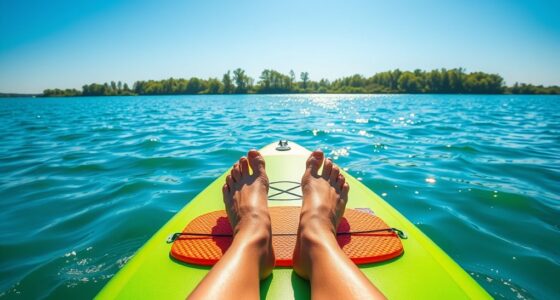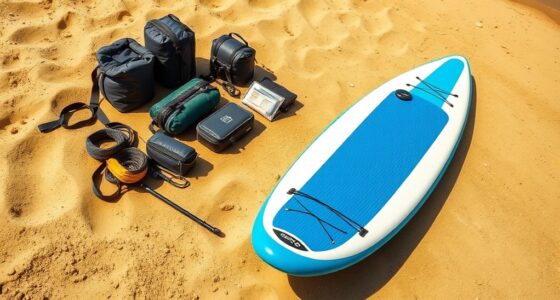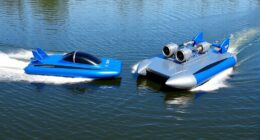As you move from flatwater to rapids, focus on improving your paddle techniques to stay controlled and confident. Use your torso and core to power strokes and switch to aggressive strokes near obstacles, keeping your paddle submerged at a steady angle. Stay alert and plan your route to avoid hazards, maintain relaxed body positioning, and use proper grips for better stability. Continuing to sharpen these skills will help you navigate rapids safely and with confidence.
Key Takeaways
- Practice proper paddle techniques on flatwater to build confidence and control before approaching rapids.
- Maintain awareness of water conditions and identify hazards to plan a safe route through turbulent sections.
- Keep body relaxed and use torso and core for power to enhance stability during rapid transitions.
- Wear safety gear, including a helmet and life jacket, to ensure protection in unpredictable water situations.
- Approach rapids with deliberate, confident movements, adjusting paddle angle and grip for optimal maneuverability.

Have you ever wondered how to smoothly shift from paddling calm, flatwater to steering fast-moving rapids? Switching from peaceful waters to turbulent rapids can be exciting, but it requires a clear understanding of paddle techniques and the right safety gear. Your approach should be deliberate and confident, ensuring your movements are precise to maintain control and stay safe.
Start by refining your paddle techniques. As you near the rapids, focus on efficient strokes that give you maximum control. Use your torso and core to power your paddling, rather than just your arms — this gives you better stability and reduces fatigue. When approaching the rapid section, switch to more aggressive, deliberate strokes like the J-stroke or sweep stroke, which help you steer and maintain your course. Keep your paddle submerged at a consistent angle, and avoid overreaching, which can cause instability. Practicing these techniques on flatwater beforehand will boost your confidence when you need them most. Additionally, understanding your projector’s contrast ratio can be akin to recognizing the importance of contrast in visual clarity, ensuring you can spot obstacles clearly amidst turbulent waters.
Refine your paddling with efficient strokes and core power for better control and confidence in rapids.
Equally important is having the right safety gear in place. Always wear a properly fitted life jacket designed for whitewater or turbulent conditions. This gear keeps you afloat and provides essential support if you fall into the water. A helmet is essential, especially in rapids where rocks and sudden drops pose hazards. Consider additional safety equipment such as a throw rope, a whistle, and a waterproof communication device. These tools can be lifesavers if you encounter trouble or need assistance.
As you move from flatwater to rapids, stay alert and keep your eyes on the water ahead. Look for potential obstacles like rocks, fallen trees, or unexpected drops, and plan your route accordingly. Keep your body relaxed; tension can impair your paddling and make it harder to react quickly. Maintain a firm grip on your paddle, but don’t squeeze too tightly — this allows for better maneuverability.
Frequently Asked Questions
What Gear Is Essential for Beginner Rapids?
For beginner rapids, essential gear includes a well-fitted helmet, a personal flotation device, and a sturdy paddle. You should also check your kayak maintenance before hitting the water to guarantee safety. Always consider weather conditions, as they influence water flow and safety. Wearing appropriate clothing for weather considerations helps prevent hypothermia or overheating. With the right gear, you’ll feel more confident and prepared for your rapids adventure.
How Do I Recognize Dangerous Rapids?
You recognize dangerous rapids by observing water turbulence and spotting obstacles early. Look for large, swirling currents, standing waves, or sudden drops, which signal rough waters. Keep an eye out for submerged rocks, fallen trees, or debris that can cause trouble. If the water looks chaotic and unpredictable, it’s best to proceed with caution or avoid that section altogether. Staying alert helps you navigate safely through potentially hazardous rapids.
What Skills Should I Practice Before Tackling Rapids?
Before tackling rapids, you should practice essential skills like reading water and executing eddy turns. Visualize the water’s flow to anticipate obstacles and identify safe routes. Master reading water by observing currents, waves, and obstacles. Practice eddy turns to control your boat’s position and direction. These skills boost your confidence and safety, ensuring you can navigate rapids effectively and respond quickly to changing conditions.
How Can I Improve My Paddling Technique in Rapids?
To improve your paddling technique in rapids, focus on paddle stroke refinement and body positioning. Practice smooth, efficient strokes that maximize control and power, especially in turbulent water. Keep your body centered and slightly forward, engaging your core to maintain balance. Regular drills help build muscle memory, making your movements more precise. Stay relaxed, anticipate rapid features, and adjust your paddle and body to navigate safely and confidently through challenging sections.
What Should I Do if I Fall Into the Water?
Imagine the thrill of conquering rapids, but if you fall into the water, stay calm—your safety relies on it. Use water rescue and self rescue techniques to stay afloat and signal for help if needed. Keep your body relaxed, float on your back if possible, and look for a safe exit point. Practicing these skills ensures you’re prepared, turning a fall into a manageable situation rather than a dangerous one.
Conclusion
As you gently step from calm waters into the lively embrace of rapids, remember that every journey has its gentle beginnings. Embrace the thrill with patience and respect, allowing your skills to blossom gradually. With each bend and swirl, you’ll find confidence growing softly within you. Trust the flow, stay alert, and enjoy this new chapter—where every ripple and rush whispers opportunities for growth and adventure. Your river awaits, ready to share its secrets when you’re ready to listen.










